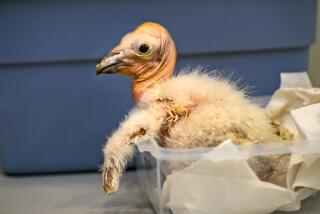Peregrine Falcon Winning Quest for Survival
- Share via
BOSTON — The peregrine falcon, once reduced to fewer than 100 pairs in the United States, is making a comeback as hundreds swoop off cliffs, ledges and, in many cases, skyscrapers.
After 15 years and millions of dollars, conservationists say the birds soon won’t need special protection, possibly by 1995. But they worry that Congress and others will decide that time is now.
“It’s progressed marvelously. It’s probably not true that the bird is widely endangered now,” said Jim Enderson, a Colorado College biologist who heads a federal peregrine recovery team.
“It’s been a model program nationally,” said Brad Blodget, Massachusetts’ state ornithologist. “It’s a victory story.”
Within five years, Enderson said, the government could probably “down-list” the bird from endangered to threatened, or even take it off the lists altogether.
This is big news for the peregrine. Once totaling about 300 pairs in the East and many more in the West, the falcon population was hard hit in the 1950s by DDT and other insecticides. By 1975, there were no falcons known to survive on the East Coast, and fewer than 100 pairs were counted in the entire continental United States.
“We were basically starting from zero,” Blodget said.
Groups such as the Boise, Ida.-based Peregrine Fund set about reintroducing the falcon, importing hatchlings from Canada, Scotland, Argentina and other countries.
The federal government, which banned DDT for nearly all purposes, earmarked about $300,000 a year for captive falcon breeding. Some states even put check-off options on tax forms to extend a portion of rebates to peregrine recovery.
Nationally, the efforts have cost “many millions of dollars,” said Bill Burnham, president of the Peregrine Fund, which spends about $800,000 a year on peregrine recovery.
“It’s a lot cheaper to take care of the environment, rather than trying to go in afterward and put them back after you lose them,” he said.
Falcon recovery cost so much in part because it entails more than just releasing an Argentine bird in Montana. Mortality rates are as high as 50% in the bird’s first year, and remain at about 15% through its lifetime, Burnham said.
The Peregrine Fund will release its 3,000th falcon this year, Burnham said. In California, where more than 500 birds were released in the 1980s, 90 pairs exist, up from eight pairs in 1975.
Today, there are more than 540 falcon pairs in the United States. Almost 100 pairs are in the Grand Canyon alone. In the Northeast, at least 85 pairs have been counted, while about 17 pairs are known in the Midwest.
“As long as the pesticide situation does not change for the worse, it’s unlikely that this bird is going to be in trouble in the foreseeable future,” Enderson said.
Other conservationists are more cautious.
“We’re about two-thirds of the way there,” Burnham said. “As far as the release of the peregrines go, there’s probably a need for another six to seven years.”
The birds remain scarce in some places, such as Idaho, where only three pairs are known. So, conservationists say, they are keeping anxious eyes on Washington, hoping Congress does not pull the plug too soon.
“One of the worst things you can do is put a lot of energy into restoration and then stop it,” said Tom French, who heads the Massachusetts endangered species program.
As they are reintroduced to modern society, some peregrines are showing a taste for urban life, where high-rise buildings resemble their preferred high cliffs and rocky ledges.
Nine pairs swoop and dive among the skyscrapers and sloping bridges of New York City, while in Springfield, Mass., peregrines nesting on a 23-story building have become stars of a local cable television show.
But with the falcon’s new surroundings have come modern hazards such as high wires, airplanes and plate-glass windows. Conservationists say too many collisions with planes or decapitations by wires could cripple breeding efforts.
“Last year one of the adult males flew over the airport and was hit by an airplane and killed, right in the middle of breeding season,” said Pat Redig, who heads the Midwest-based Raptor Center. “I’ve seen those things happen with enough frequency to cause me to be concerned about the fragility of our population.”
More to Read
Sign up for Essential California
The most important California stories and recommendations in your inbox every morning.
You may occasionally receive promotional content from the Los Angeles Times.













